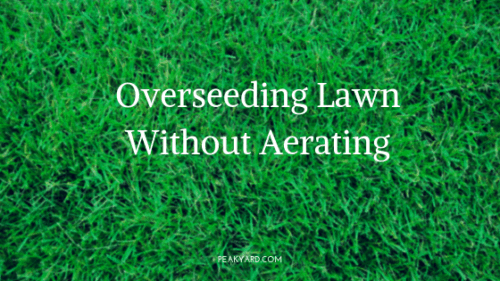Aeration is often one of the keys to establishing or maintaining a thick, lush lawn. Take a look at our article on aeration to learn why it is so beneficial for lawns. Despite these benefits, you can still overseed a lawn without having to aerate.
Overseeding occurs when grass seed is spread across the existing lawn. The grass seed makes it way to the lawn soil and eventual germinates with proper care as we will discuss below. Overseeding is especially helpful for thinning lawns where the new grass can fill in undesirable spots to thicken up the lawn.
Keep in mind that sometimes it may more beneficial to kill off the existing lawn with something like Round Up Grass Killer and start fresh with a reseed. An example of when you might do a complete a lawn renovation is when your existing lawn has been taken over by weeds or an unwanted grass. Overseeding is typically done when you are mostly satisfied with your existing lawn, but want to add turf density to it.
Below we have outlined the steps on how to overseed a lawn without aerating. While we do recommend aerating, you can still achieve solid results from following the overseeding tips below.
Table of Contents
Overseeding Without Aerating
- Timing – The best time to overseed a cool-season lawn is in the early fall. During this time, weeds tend to be at a minimum and the soil temperatures have cooled to created the ideal conditions for root growth. You can also consider overseeding in the spring but weeds thrive during this season. There may be an issue weeds interfering with grass growth if weeds are excessive in your lawn. Warm-season grasses grow best in the late spring to early summer.
- Select the Seed – You should carefully select your grass seed since you will likely be looking at the grown result for years to come. Do some research on the best grass seed for your region. Grass seed is rarely an area where you want to cut costs. A low quality (often cheap) grass seed will commonly cause more problems and money down the road. Be prepared to pay for premium grass seed if you want a lasting quality lawn. Lastly, it is often best to select grass seed that matches your existing lawn, so that texture and potentially color remain consistent.
- Prepare Lawn – Give your lawn a good rake to collect debris, clippings, thatch, and other material that may prevent the seed from reaching the soil. Since you are losing the benefit of loosening the soil from aeration, a solid raking will help loosen the soil so that the seed has better seed-to-soil contact. If you have a thick thatch layer, you may consider purchasing or renting a dethatcher before seeding.
- Bag Mow Low – Mow the lawn low so that the seed has an easy path to the soil. The length should only be about an inch from the ground.
- Spread the Seed – Use a broadcast spreader to spread the seed over the lawn. The seed manufacturer will often provide the recommended spreader setting. If you cannot obtain the spreader settings, you can use the below general data for grass seed. Increase the amount of seed in bare or extremely thin spots in the lawn.
Type of Seed Pounds per 1,000 square feet Kentucky Bluegrass & Rough Bluegrass 2-3 lbs Turf-Type Tall Fescue 6-8 lbs Fine Fescue 4-5 lbs Turf-Type Perennial Ryegrass 4-5 lbs - Fertilize- Apply a starter fertilizer such as Scott’s Turf Builder Starter to provide the seedlings with vital nutrients to help the grass grow thick. Only use a starter fertilizer or products designed for new grass/seed. Traditional fertilizers and weed killers can kill the seeds.
- Water – Irrigation is a key factor in establishing the new seed. Watering should be completed twice a day or more if conditions are dry and/or hot. The benefit of seeding in the fall and spring is that these seasons tend to wet. There will likely be days (hopefully many) where watering is not necessary because of the natural moisture created by Mother Nature. Watering should be continued until the seed has grown to the height of the existing lawn. A soil moisture meter can be used to get an idea of how much water the lawn is receiving.
Overseeding Q&A
The seed can take as little as a few days to approximately a month. The type of seed you buy and other factors such as watering, temperature, and so on will factor into the germination time of seeds. Please view our article on how long it takes grass seed grow for additional information on this topic.
If your existing lawn is having trouble staying health, you should consider getting a soil test to determine if the pH level is off. Lawn soil that is too acidic or alkaline will commonly have trouble maintaining a beautiful, lush appearance. A quality soil test will provide valuable information to determine what is wrong with your lawn, if anything, and inform you how to fix the problems.
We highly recommend against it. You will likely will not receive desirable results since growing conditions are not ideal. Save yourself from potential disappointment and wait until fall when conditions are optimal.
You will need to read the specific product label to determine an accurate answer. For example, the Scott’s Weed and Feed label indicates to wait at least 30 days before seeding after applying the product. However, a product such as Jonathan Green Crabgrass & Weed Prevent states to wait at least 12 weeks before seeding. How long you need to wait will depend on the weed killer you use.
Calculating the square footage of your yard is important to determine the amount of seed you will need. To calculate square footage, grab a tape measure and measure your lawn based on its shape (see the square footage calculations below):
- Square and Rectangle – Length x Width
- Right Triangle – (Length x Width) ÷ 2
- Circle – (Radius x Radius) x 3.14
- Half Circle – [(Radius x Radius) x 3.14]÷2

